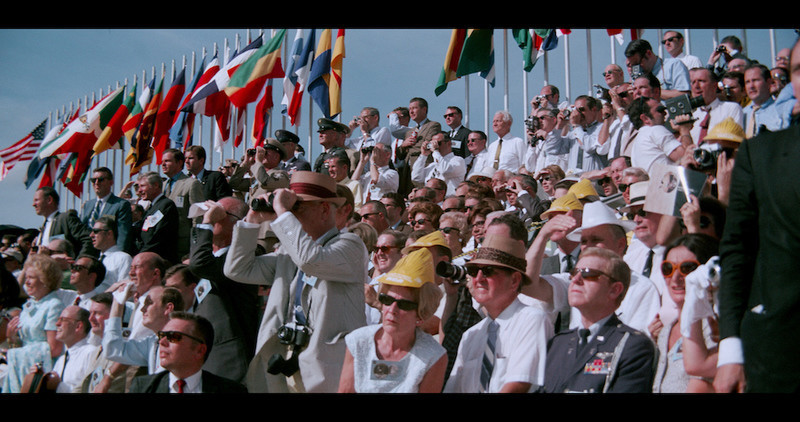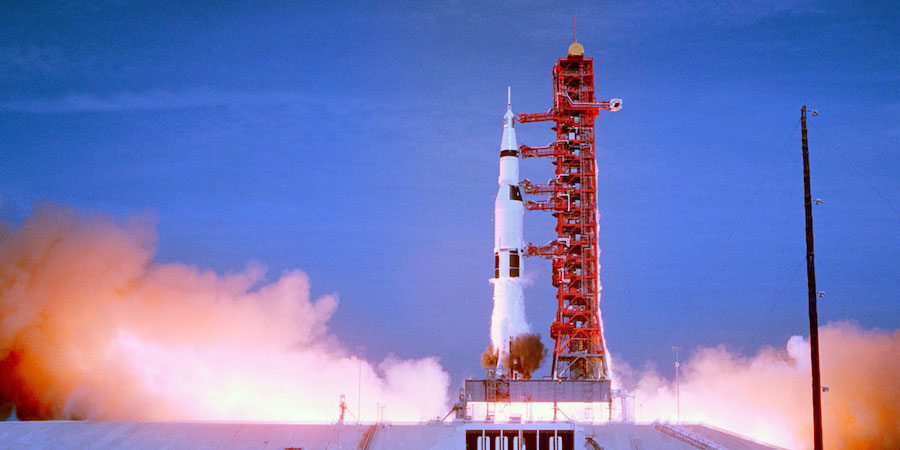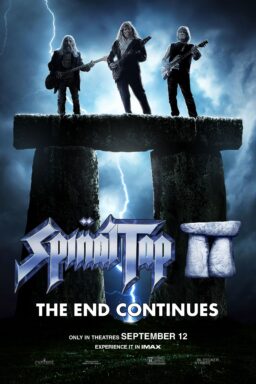Todd Douglas Miller is the director of “Apollo 11,” the extraordinary new IMAX film that takes us inside the first manned mission to land on the moon. Miller spoke to RogerEbert.com about being the first to see much of the footage that was shot at NASA during the mission, using today’s technology to preserve its immersive images, and why he chose to present it without any narration or updates.
Who shot the original footage?
It was a combination of things. First off NASA actually had a couple of large format cameras through Technicolor that were stationed down there at Cape Canaveral (it was called Cape Kennedy at the time), so they were actually shooting on these large format cameras as early as some of the later Gemini missions and certainly by Apollo 8, 9, and 10. What was really special on 11 was there was a production that was commissioned by NASA; there was a PR director who was working with a large format film company called The Francis Thompson Company. The film was to become a space classic among space enthusiasts called “Moonwalk One.” It was Theo Kamecke’s first directing gig but he had edited large-format films mainly for special venues and expos which is where the stuff usually got presented. Theo got a couple of really great cinematographers, one named Urs Furrer. They called him The Bear and he would hand hold these giant Mitchell 65mm cameras and get all these great shots, which we utilized in the film. There was another Dutch filmmaker who got all these great shots of all the crowds, the day of the launch also the night before of faces of people witnessing Apollo 11 take to the sky so we owe a debt of gratitude to not only those guys but also all the folks that were shooting on all these large format cameras. Also there was a 70mm engineering camera that was a different flavor of large format but they were all those great slow motion shots of the rocket Saturn V taking off of the pad and also in flight before getting into orbit during this staging sequences. Those were shot with large format cameras on aerials and also from the ground.
I remember very well watching it on television when I was a teenager and it was very grainy and dim. So it was quite a shock to see how vivid the footage on the moon was. What kind of setup did they really have?
So on the moon there was no large format film footage per se but they did have what they call data acquisition cameras. There were 16mm cameras. They had one on board the lunar module and one on board the command module. But what’s interesting is, with Apollo 11 it wasn’t really their mission to document their journey. It was to get there, land, and return home safely so unlike a lot of the other Apollo missions they really didn’t document as much. But they still did a lot and one piece of media that I think is always underutilized is the still photography. Even though it wasn’t their mission to photograph it, they still took 1,025 images spread across seven different still magazines and these were all captured 70mm and they were absolutely gorgeous and stunning. So we definitely wanted to utilize those on the film and not do it in a way that I had always seen it depicted which was to kind of flash them on and off but to actually keep them up on screen for a while and have people see all the detail and all the wonderful things that are in the frame. It’s truly mind-boggling to see it on an IMAX screen and in that kind of detail.

Did the astronauts have training on how to take pictures? How do you even tell them how to light meter for the moon when no one’s ever been there?
It’s one of the great untold stories. We have large format footage of them training with that equipment. On the air to ground transmissions you just hear them talking endlessly about the F-stops and the different film negatives that have been exposed: “Oh, should we put magazine Z in or magazine J or TT?” Or “What are we using for this?” “What are we using for that?” Between the three astronauts they take turns on who’s going to do what and obviously it was all scripted, it was in their Flight Plans when things need to be photographed, when to use the still camera and when to use the film camera. So it’s a real testament to not only them as explorers and scientists but also as photographers. These guys were all in the society of cinematography (the American Society of Cinematography) they were all ASC members. Some of my favorite film footage in history was shot by the Apollo 11 crew: Buzz Aldrin shot the landing on 16mm camera and Michael Collins shot the lunar module coming up from the surface of the Moon with a 16mm camera. We showed both of those and the film was unbroken shots and they are some of my favorite cinematic moments.
I read that it was not in their flight plan to take pictures of the Earth, but of course that’s the most powerful image of all.
Yes, it’s been said before: to go to the moon we had to discover the earth. One of the great images that really spurred the environmental movement was taken on Apollo 8 and more on the subsequent missions of photography of the Earth. One of the most interesting things to hear on the air to ground transmissions is them just describing weather patterns back to mission control. They’re in space and they’re basically forecasting the weather to them. They’re like early meteorologists, too, aside from doing everything else they had to do on the mission.
And some of the film had never even been developed before?
<span class="s1" That’s correct. There was a ton of negatives that had never been scanned. Primarily the technology just didn’t exist to be able to do it not only with the quantity that we had to deal with but also in the time it took to do it. There were other film scanners that could have done it certainly not in the resolutions with the scanners that we built to handle all this but probably the most important piece was in the hardware; everything rode on a cushion of air so it allowed us to have a wide variety of different large formats going through the scanner and also to deal with some of the other formats—35mm, 16mm etc. So the store solutions, workflows and all of it was new and it’s a real testament to the teams and the post-production house, Final Frame in particular up in New York, that did all of the back-end systems.

Don’t you risk making it very grainy when you blow it up to IMAX?
Actually it was scanned in 8K and IMAX and any time it’s exhibited it’s actually in 4K but we utilize an 8K workflow. So right now the technology doesn’t exist to exhibit it in the way in which we scanned it and there was kind of a diminishing return. So there’s actually more there and just not it’s when we say 4K to 8K people think that’s double the resolution, it’s actually 75 percent more there. So there’s actually a version of this in the future that will even be better quality than what you see now.
What made you decide not to do the conventional approach with narration and updates and interviews and talking heads?
I’m a fan of direct cinema films. I try to be a student of cinema, particularly large format films primarily from the ‘50s and ’60s. It’s an art form in my mind to tell a story in a completely conventional direct cinema approach. Obviously in its purest sense, we don’t do that—we have music, we have sound design—but I’ve always been a fan of that. I really saturated myself with all the space films about Apollo 11 and read all the books and one thing that always popped out at me was just to let the imagery happen. It was always so gorgeous. People know about the mission so we really didn’t have to describe every minute of what was happening. We could just let it stand on its own merits and kind of get out of the way of it and just to let it unfold.
What do you want people to take away from this film?
I really just want them to talk about what a great endeavor this was. There were hundreds of thousands of people involved in Project Apollo. It was spread across tens of thousands of companies. When we all come together, when a great number of us come together, we can accomplish great things.












